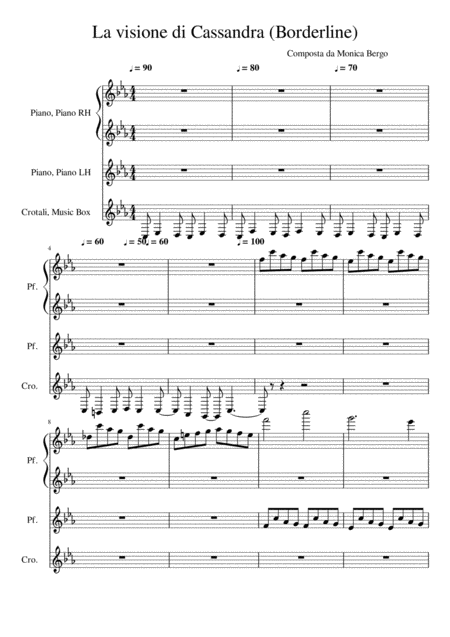Small Ensemble Piano - Level 3 - Digital Download SKU: A0.976860 Composed by Monica Bergo. Contemporary. Score and parts. 19 pages. Monica Bergo #3238295. Published by Monica Bergo (A0.976860). 2017 Holiday Contest Entry♫*´¨`*•.¸¸.♫ La visione di Cassandra ♫*´¨`*•.¸¸.♫ Non vorrei aprire quella porta ,Non dovrei…ma è il vento che mi porta… E canto a voce bassa, Finchè il dolore passa e giro, giro-tondo ,com’è cattivo il mondo Tra pensieri e lacrime, Parole e musica C’è la visione di Cassandra E non so se potrà farcela, a scrivere di te ,Te ne sei andata in fretta , E sei perfetta Nella mente mia Cassandra sta Rinchiusa in quella stanza, Si stringe a sé ,Racconta un’esistenza: guarda là , mio padre e il suo bicchiere, guarda me, la vittima del bere lividi viola, a scuola sempre sola ,nell’indifferenza continua la violenza , mia madre sapeva ma tutto nascondeva ,la mente che non regge , e il borderline distrugge la scintilla che era in me, tutti quei sogni miei e quell’amore che non avrò mai, vorrei scappare ma sto incatenata qua, rituali incontrollati, gesti ripetuti ed un mostro chiuso dentro me Nella visione di Cassandra, Non ha più sbarre questa stanza non ha più un corpo, sesso ,è senza età È una visione ma lei non lo sa In armonia con il creato, Scorda il presente ed il passato Ed il dolore affiora e sparirà ,È una visione ma lei non lo sa Cassandra non lo sa, Che sta per perdere la nostra realtà Fili sdruciti Di un pupazzo fragile Rimane in bilico, Abbraccia un incubo Nei labirinti suoi , Non trova uscite mai E passa il margine, varca quel limite Si sente un fiore che Bisogni più non ha Ed il vento seguirà Davanti allo specchio ,I lunghi capelli, Rifletton bagliori di mille cristalli Li pettini piano,, Con cura infinita, Aspetti il tuo amore da tutta una vita Ed un carillon che risuona lontano ,La spazzola a un tratto ti cade di mano Perché l’uomo nero è qui, è già tornato, Infrange il tuo sogno, l’incanto è spezzato Cassandra corre tra le stelle E se le tatua sulla pelle Lividi e cicatrici più non ha, È una visione ma lei non lo sa In dimensioni da esplorare ,Come gli uccelli può volare Respira sole , amore e libertà E qui nessuno male le farà … Cassandra fermati, Cassandra aiutami a non rimpiangerti Adesso tu non puoi incatenarmi a te ,Al tuo ricordo che per sempre brucierà Cassandra non lo sa che le ali no, non ha Tragico angelo che prende il volo e poi Un burattino con i fili rotti ormai E il tempo è fermo qui, come il tuo battito Ma la visione è mia o di Cassandra, Non ricordo più, Questo tempo cambia La mia percezione del passato Volti e nomi che Il tempo ormai ha sbiadito E danzo al ticchettio di ciò che è stato anime perse che son rimaste indietro sempre dentro me con la loro storia un tatuaggio eterno nella mia memoria Non dovrei aprire quella porta ,Non vorrei, ma è il vento che mi porta…. e canto a voce bassa finchè il dolore passa e giro, giro-tondo com’è cattivo il mondo….. Monica Bergo
